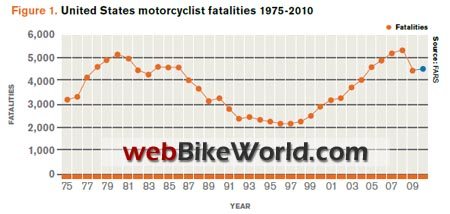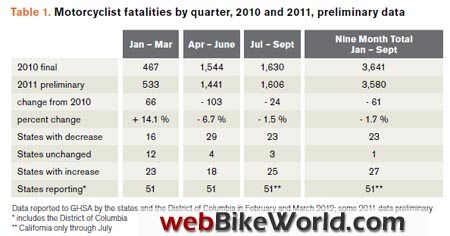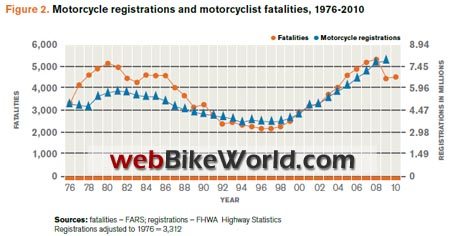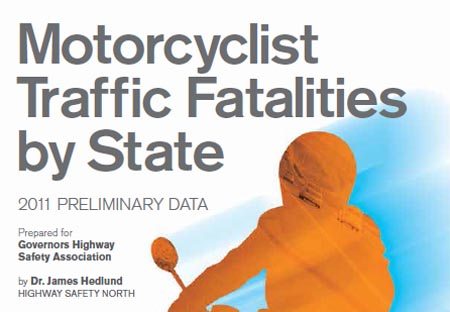U.S. Motorcyclist Traffic Fatalities by State: 2011 Preliminary Data
May 22, 2012 – A report released today by the U.S. Governors Highway Safety Association (GHSA) finds that no progress was made in reducing motorcyclist deaths in 2011.
Based upon preliminary data from 50 states and the District of Columbia, GHSA projects that motorcycle fatalities remained at about 4,500 in 2011, the same level as 2010.
Meanwhile, earlier this month, the National Highway Traffic Safety Administration projected that overall motor vehicle fatalities declined 1.7 percent in 2011, reaching their lowest level since 1949. Motorcycle deaths remain one of the few areas in highway safety where progress is not being made.
The new report (download the .pdf here), which is the first state-by-state look at motorcycle fatalities occurring in 2011, was authored by Dr. James Hedlund of Highway Safety North.
 Most states have reasonably complete fatality counts for at least the first nine months of 2011, enabling GHSA to confidently project the full year. Dr. Hedlund completed similar projections for GHSA in 2009 and 2010, with both being very close to the final fatality numbers.
Most states have reasonably complete fatality counts for at least the first nine months of 2011, enabling GHSA to confidently project the full year. Dr. Hedlund completed similar projections for GHSA in 2009 and 2010, with both being very close to the final fatality numbers.
Comparing the first nine months of 2010 to 2011, motorcyclist fatalities decreased in twenty-three states, with notable declines in many. In Connecticut, for example, motorcycle deaths dropped 37 percent, while in New York and North Carolina they fell 16 and 21 percent, respectively. GHSA’s member in New York State is the Governor’s Traffic Safety Committee (GTSC).
According to Barbara J. Fiala, Commissioner of the New York State Department of Motor Vehicles and Chair of GTSC, the decrease in fatal motorcycle crashes in that state is due to a mix of countermeasures focusing on enforcement, education and engineering. “In New York, we are educating motorists to watch for motorcycles, riders to wear bright protective gear to make themselves more visible, and law enforcement officers on conducting efficient and effective motorcycle checks,” Fiala said.
“It is encouraging to see that these efforts, which have been conducted with our state and local partners, are making a difference.”

GHSA’s Immediate Past Chairman and Director of California’s Office of Traffic Safety, Christopher J. Murphy, pointed out that the state experienced a dramatic 37 percent decline in motorcycle deaths from 2008 to 2010, so while disappointing, it would not be unexpected to see a smaller decline or even an increase, for 2011.
The economy influences motorcycle travel in several ways. With the economy improving in 2011 and furthering strengthening in 2012, more people will have disposable income for purchasing and riding motorcycles. At the same time, rising gas prices may cause more individuals to choose motorcycles for transportation because of their fuel efficiency.
For his work on behalf of GHSA, Dr. Hedlund compared gas prices, motorcycle registrations, and motorcyclist fatality trends since 1976. He found that for the entire period fatalities closely track registrations, with significant similarities from 1990 to 2008. At the same time, as gas prices increase, fatalities also rise.
 Another disturbing trend is the decrease in states with universal helmet laws. Helmet laws are the only motorcycle safety strategy whose effectiveness is rated as five-star in NHTSA’s highly-regarded publication, “Countermeasures That Work.”
Another disturbing trend is the decrease in states with universal helmet laws. Helmet laws are the only motorcycle safety strategy whose effectiveness is rated as five-star in NHTSA’s highly-regarded publication, “Countermeasures That Work.”
Only 19 states currently require all riders to wear helmets, down from 26 in 1997. Earlier this year, Michigan repealed its universal helmet law, while similar legislation has been introduced in five other states. No state has enacted a universal helmet law since Louisiana reinstated its requirement in 2004.
Troy Costales, GHSA Chairman said “It is disappointing that we are not making progress in motorcycle safety, particularly as fatalities involving other motorists continue to decline. As the study notes, the strengthening economy, high gas prices, and the lack of all-rider helmet laws leave me concerned about the final numbers for 2011 and 2012. Every motorcyclist deserves to arrive at their destination safely. These fatality figures represent real people – they’re family, friends and neighbors.”
Costales added “The good news is that we know how to prevent crashes and the resulting injuries and fatalities involving motorcycle riders’ and their passengers. There are effective strategies that, if implemented, can make a difference.”
Specifically, the report recommends states address five issues:
Increase helmet use: Helmets are proven to be 37 percent effective at preventing fatal injuries to motorcycle operators and 41 percent effective for passengers. NHTSA estimates that helmets saved 1,829 motorcyclists’ lives in 2008 and another 822 of the un-helmeted motorcyclists who died in that year would have survived had they worn helmets.
Reduce alcohol impairment: In 2010, 29 percent of fatally injured riders had a blood alcohol concentration at or above the legal limit of .08, the highest of all motorists. Reduce speeding: According to the most recent data, 35 percent of motorcycle riders involved in fatal crashes were speeding, and more than half did not involve another vehicle.
Provide motorcycle operator training to all who need or seek it: While all states currently offer training programs, some courses may not be provided at locations and times convenient for riders.
Encourage all drivers to share the road with motorcyclists. According to NHTSA, when motorcycles crash with other vehicles, the latter usually violates the motorcyclist’s right of way. Many states conduct “share the road” campaigns to increase awareness of motorcycles.
This report comes just before Memorial Day Weekend, when at least five large motorcycle rallies are planned across the country, including “Rolling Thunder”, where approximately 100,000 motorcyclists convene in Washington, D.C. to pay tribute to the nation’s veterans.
As Chairman Costales noted, “With so many motorcyclists on the road this month, it’s an opportune time to remind all motorists about this critical highway safety issue.”
All data in the report are preliminary. The report presents data through September 2011. State-by-state data are available from GHSA.
More wBW: Motorcycle Reviews | Product Reviews | BMW Motorcycles



No Comment